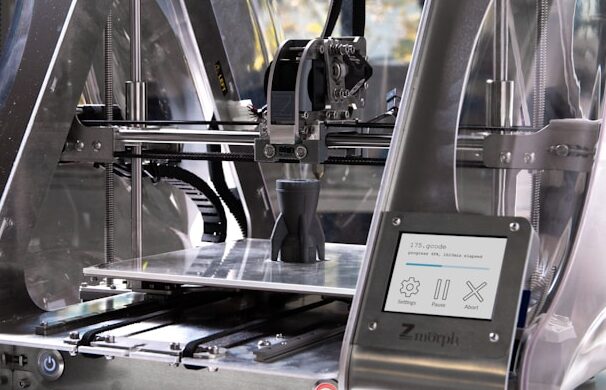Revolutionizing Industries: Top Applications of 3D Printing in 2024

3D printing is transforming industries in 2024, driving innovation and efficiency through its versatile applications. From healthcare and aerospace to consumer goods and construction, this technology continues to redefine boundaries, offering sustainable, cost-effective, and customized solutions. As companies invest in additive manufacturing, its impact on global markets grows exponentially.
This article explores the top applications of 3D printing in 2024, detailing breakthroughs, real-world examples, and future potential that promise to reshape industries worldwide.
Healthcare: Customized Patient Solutions
Personalized Prosthetics and Implants
3D printing allows for creating custom prosthetics and implants that align with individual patient anatomies. Advanced imaging and biocompatible materials ensure optimal comfort and functionality. Companies like Materialise and Stryker are at the forefront of these innovations in 2024.
-
Case Study: The Mayo Clinic used 3D-printed titanium hip implants for a complex injury, reducing recovery time by 30%.
Bioprinting Tissues and Organs
Bioprinting is advancing the creation of organoids and tissues for research and transplantation. Using bio-inks and scaffolding techniques, researchers now produce tissues with vascular networks—a critical step toward printing fully functional organs.
-
News Highlight: MIT researchers achieved a breakthrough by bioprinting a kidney prototype, setting the stage for organ transplants.
Surgical Planning Models
3D-printed models based on patient imaging enhance surgical precision, especially in complex procedures. Tools like Stratasys’ J750 Digital Anatomy Printer improve surgical outcomes in cardiac and cranial operations.
Automotive Industry: Accelerating Innovation
Rapid Prototyping and Design
3D printing accelerates design iterations, enabling faster and more cost-effective prototyping. Automotive giants like Tesla and BMW utilize additive manufacturing to streamline R&D processes.
-
Example: BMW’s iFACTORY program employs 3D printing to create lightweight parts, enhancing vehicle efficiency.
Production of Spare Parts
On-demand manufacturing of spare parts reduces inventory costs and lead times. In 2024, decentralized 3D printing hubs revolutionize spare parts logistics.
-
News Highlight: Mercedes-Benz leverages EOS 3D printers for spare part production, minimizing fleet downtime.
Customization in Luxury Vehicles
Luxury carmakers offer bespoke interiors and performance-enhancing components using 3D printing. Bugatti’s 3D-printed titanium brake calipers exemplify high-performance customization.
Aerospace: Lightweight and Durable Components
Aircraft Components
3D printing’s ability to create lightweight, durable parts enhances aerospace manufacturing efficiency. GE Aviation’s LEAP engine—featuring 3D-printed fuel nozzles—remains a leading innovation.
Space Exploration
Additive manufacturing supports in-space production of tools and components. Organizations like NASA and SpaceX employ 3D printing to optimize space missions.
-
News Highlight: NASA’s Artemis mission utilized 3D-printed components for its lunar lander, increasing mission reliability.
Construction: Transforming the Built Environment
3D-Printed Homes
Affordable housing becomes achievable through 3D printing. Companies like ICON and Mighty Buildings lead initiatives to address housing shortages with eco-friendly solutions.
-
Example: In 2024, ICON completed a 3D-printed housing community in Texas, cutting costs by 30%.
Infrastructure Projects
Large-scale printers create sustainable bridges, buildings, and infrastructure components with reduced waste.
-
News Highlight: A 3D-printed pedestrian bridge in Amsterdam demonstrates the potential for urban transformation.
Consumer Goods: Enhancing Personalization
Fashion and Jewelry
3D printing enables intricate designs and bespoke creations in fashion and jewelry. Luxury brands like Dior integrate this technology into their production.
-
Example: Custom jewelry lines featuring intricate 3D-printed designs redefine personalization.
Footwear
Major footwear companies like Adidas utilize 3D printing for customized insoles and prototypes.
-
News Highlight: Adidas’ Futurecraft initiative features recyclable 3D-printed midsoles, advancing sustainability.
Education and Research: Enabling Innovation
Academic Applications
Universities incorporate 3D printing into curriculums, fostering hands-on innovation and creativity.
-
Example: MIT’s Makerspaces support advanced 3D printing projects for students.
Scientific Research
3D printing accelerates advancements in material science, robotics, and medicine, enabling rapid prototyping of experimental models.
-
News Highlight: Researchers at Stanford developed a 3D-printed robotic hand for prosthetic studies, showcasing biomimetic potential.
Sustainability: Driving Green Initiatives
Reduced Waste
Additive manufacturing minimizes material waste, promoting sustainability in manufacturing.
Recycling Initiatives
Recycled materials now serve as high-quality filaments for 3D printers, contributing to a circular economy.
-
Example: Reflow converts plastic waste into functional 3D printing materials.
Emerging Trends and Future Potential
AI-Driven Design
Artificial intelligence enhances 3D printing by optimizing designs for performance and manufacturability. AI-powered tools streamline workflows across industries.
Distributed Manufacturing
Decentralized 3D printing reduces logistical complexities and carbon footprints.
-
Case Study: HP’s Multi Jet Fusion technology underpins decentralized production networks, revolutionizing supply chain models.
3D printing in 2024 exemplifies technological progress, offering transformative solutions across healthcare, automotive, aerospace, and more. As innovations expand and adoption grows, industries worldwide unlock unprecedented opportunities for customization, sustainability, and efficiency.
Visit our other website: https://synergypublish.com





